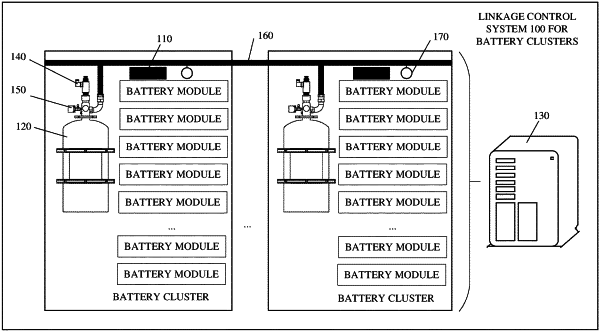| CPC A62C 3/16 (2013.01) [H01M 10/482 (2013.01); H01M 10/486 (2013.01); H01M 50/383 (2021.01); H01M 2200/10 (2013.01); H01M 2200/20 (2013.01)] | 12 Claims |

|
1. A linkage control system for battery clusters, comprising a plurality of detector modules, a plurality of isolation-and-suppression devices, and a control host, wherein
the plurality of isolation-and-suppression devices are respectively disposed in the battery clusters, each of the plurality of isolation-and-suppression devices is provided with a solenoid valve, and the plurality of isolation-and-suppression devices are connected by a pipeline;
the plurality of detector modules are respectively mounted in the battery clusters, and each of the plurality of detector modules is configured to detect environmental data of battery modules in a corresponding battery cluster and periodically report the environmental data; and
the control host is configured to determine a first target battery cluster in which thermal runaway occurs according to the environmental data, and determine whether an inhibitor in an isolation-and-suppression device A in the first target battery cluster is in a normal state, wherein when the inhibitor in the isolation-and-suppression device A is in an abnormal state, the control host is configured to determine a second target battery cluster in which an inhibitor is in the normal state from other battery clusters except the first target battery cluster, and switch on a solenoid valve of an isolation-and-suppression device B in the second target battery cluster to let the inhibitor in the isolation-and-suppression device B be conveyed to the first target battery cluster through the pipeline to solve thermal runaway;
wherein the environmental data comprises temperature data, and in terms of determining the second target battery cluster in which the inhibitor is in the normal state from the other battery clusters except the first target battery cluster, the control host is configured to:
for each battery cluster among the other battery clusters except the first target battery cluster, obtain a probability of thermal runaway of said each battery cluster in a next period based on temperature data of said each battery cluster in a current period and temperature data of said each battery cluster in a historical period;
obtain a confidence score for an isolation-and-suppression device in said each battery cluster supporting the first target battery cluster, according to the probability of thermal runaway of said each battery cluster in the next period, and a pipeline length between the isolation-and-suppression device in said each battery cluster and a spraying device for the inhibitor in the first target battery cluster; and
determine a battery cluster in which an inhibitor is in the normal state and which has a lowest confidence score among the other battery clusters except the first target battery cluster, as the second target battery cluster;
wherein in terms of obtaining the probability of thermal runaway of said each battery cluster in the next period based on the temperature data of said each battery cluster in the current period and the temperature data of said each battery cluster in the historical period, the control host is configured to:
predict temperature data of said each battery cluster in the next period by using the temperature data of said each battery cluster in the current period and the temperature data of said each battery cluster in the historical period; and
obtain the probability of thermal runaway of said each battery cluster in the next period based on the temperature data of said each battery cluster in the next period and a first preset temperature value, wherein the first preset temperature value is a battery self-heating temperature T1.
|